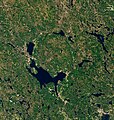Ficheiro:Sweden's Siljan Ring.jpeg

Tamaño desta vista previa: 570 × 599 píxeles. Outras resolucións: 228 × 240 píxeles | 457 × 480 píxeles | 731 × 768 píxeles | 974 × 1.024 píxeles | 1.948 × 2.048 píxeles | 3.808 × 4.003 píxeles.
Ficheiro orixinal (3.808 × 4.003 píxeles; tamaño do ficheiro: 4,65 MB; tipo MIME: image/jpeg)
Historial do ficheiro
Prema nunha data/hora para ver o ficheiro tal e como estaba nese momento.
| Data/Hora | Miniatura | Dimensións | Usuario | Comentario | |
|---|---|---|---|---|---|
| actual | 16 de novembro de 2022 ás 04:24 |  | 3.808 × 4.003 (4,65 MB) | StellarHalo | {{Information |Description=Covered with lakes, forests, and mountains, Dalarna County has been called “Sweden in miniature.” But the same region that today draws people to its idyllic lakeside villages and midsummer celebrations was also the site of an ancient, catastrophic impact. Around 380 million years ago, in the Late Devonian period, an asteroid slammed into the land that is now south-central Sweden. The impact left quite a mark. Even after hundreds of millions of years of erosion, the... |
Uso do ficheiro
A seguinte páxina usa este ficheiro:
Uso global do ficheiro
Os seguintes wikis empregan esta imaxe:
- Uso en en.wikipedia.org
- Uso en fr.wikipedia.org


